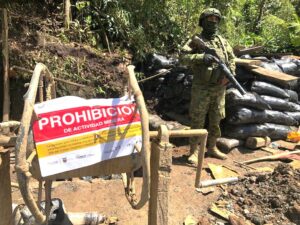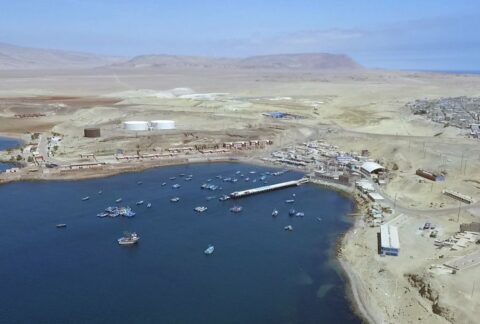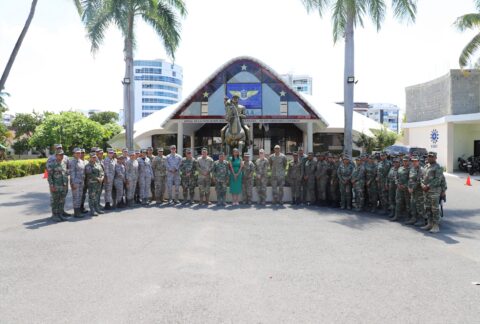Ecuador has been intensifying the deployment of its Armed Forces in nine of the provinces most affected by illegal mining, the Interior Ministry said in early May. Although authorities acknowledge that this illicit activity exists throughout the country, the military is focusing on the provinces of Napo, Orellana, Esmeraldas, Zamora Chinchipe, Azuay, Sucumbíos, Imbabura, Loja, and Morona Santiago.
“The most urgent places to attend to in Ecuador are the Napo River Basin, because there illegal mining is advancing uncontrollably. The Armed Forces are already carrying out operations and have confiscated machinery,” Andrés Tapia, director of the Confederation of Indigenous Nationalities of the Ecuadorian Amazon (CONFENIAE), told Diálogo on June 26. In Fierro Urco, in the Ecuadorian Austro, criminal groups have been entering indigenous territories to carry out illegal mining operations, while in the Shuar and Warints indigenous communities, in the province of Morona Santiago, mining is generating social divisions.
On May 5, authorities launched an intensive operation in the provinces of Napo and Orellana, in the north of the country, where more than 1,000 military personnel seized 34 excavators, more than 11,900 liters of fuel and equipment.
“Those excavators are not visible in high-resolution satellite images, because the miners hide them among the vegetation,” a representative of Ecuadorian scientific entity EcoCiencia Foundation told Ecuadorian news site Primicias. “There is a very large illegal group with the capacity to operate heavy machinery in large numbers in these areas.”
The Andean Amazon Monitoring Project estimates that 217 hectares of forest were lost since 2019 on the Punino River, Spanish news agency EFE reported. The National Water Reference Laboratory of the Amazon Regional University IKIAM also documented the environmental impact of the gold mining process in Napo.

“[There are] river diversions to get water and process the material and they deforest areas uncontrollably,” Marcela Cabrera, a chemical engineer at IKIAM, told the Youtopía Ecuador platform. “Waste containing toxic metals such as lead, arsenic, manganese, and mercury is dumped directly into the river or stored in abandoned tailings ponds.”
Scientists and conservationists also monitor the Cofán Bermejo Ecological Reserve, one of the best-conserved protected areas in the province of Sucumbíos, in Ecuador’s northern Amazon. Data from the MapBiomas Amazonía project estimates that between 2017 and 2021 the areas with mining activity in the boundaries of the reserve increased by 386 hectares. This means a growth of more than 350 percent, the Mongabay Latam environmental news site reported on June 6.
The authorities’ security plan targets the areas where there is most conflict, mainly in the Amazon region rich in biodiversity, protected areas, and gold and copper deposits, Voice of America reported.
“We do not have exact data on how much illegal mining activity grew in the country in recent years, but it is unquestionable,” Tapia said. “Some of the major impacts of illegal mining activity in Ecuador are the contamination of water sources, social division, the advance of the extractive frontier, and the decomposition of the community social fabric.”
These effects are evident in La Merced de Buenos Aires, Imbabura province, where illegal mining is keeping the population on alert. According to Ecuadorian newspaper El Universo, security forces carried out an operation and dismantled a large campground with an artisanal mineral processing plant, five improvised camps, five sedimentation ponds, and 12 geo-referenced wells.
The Ecuadorian Army also carried out operations between June 8 and 17 in Congüime, Zamora-Chinchipe province; in the sectors of Mina Vieja and El Olivo, Imbabura province; and in Paccha and Zaruma, El Oro province.
“Illegal mining appears as an attractive alternative, as it offers greater benefits in terms of profits and little risk due to the state’s inability to understand the logics of these illegal markets,” Carlos Cabrera, an Ecuadorian political analyst, stressed via LinkedIn. “In the midst of the pandemic, the presence of these criminal gangs expanded and led to an increase in violence, homicides, and other criminal activities such as human trafficking, extortion, and cross-border smuggling of gasoline and explosives.”
The Ecuadorian government will maintain its Armed Forces in the nine provinces until late 2023, due to the voracious growth of this activity, which in January was declared a threat to national security.









